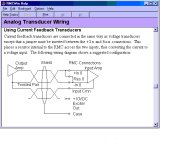All the above replies are correct. But it is worth remembering that the reason why 4-20mA current loops are so popular and effective is that the 250ohm resistor at the input is a relatively low impedance, and this fact alone makes the loop relatively insensitive to induced noise.
Simply pay attention to the cable sheilding, earthing and routing suggestions made above and there is no need for any extra filtering components at any frequencies below 10kHhz at least.
At the very worst if > 100kHz RFI is shown to be a problem then maybe winding the whole cable for 2-5 turns around a small ferrite toroid would be a help...but I have never seen this to be a problem in any normal industrial site I have been on.
The worst creators of RFI are welding machines, induction heaters, some older types of VSD, and any large DC soleniod, such as an electromagnetic brake on a motor. If any of these are a problem it is much better to reduce the RFI at the source of the problem, rather than trying to sheild every sensitive circuit on site.







